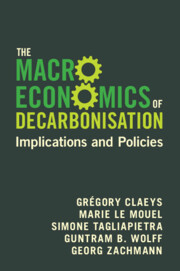Book contents
- The Macroeconomics of Decarbonisation
- Reviews
- The Macroeconomics of Decarbonisation
- Copyright page
- Contents
- Figures
- Tables
- Boxes
- Introduction
- 1 Understanding Deep Decarbonisation over the Long Run
- 2 Understanding Decarbonisation’s Short-Term Disruptions to Economic Activity
- 3 The Distributional Effects of Climate Policy
- 4 Public Finances and Decarbonisation
- 5 Greening Innovation, Industrial and Competition Policies
- 6 Mobilising the Financial System for Decarbonisation
- 7 Decarbonisation and Labour Markets
- 8 Greening Central Banks
- Conclusions
- Index
- References
1 - Understanding Deep Decarbonisation over the Long Run
Published online by Cambridge University Press: 01 February 2024
- The Macroeconomics of Decarbonisation
- Reviews
- The Macroeconomics of Decarbonisation
- Copyright page
- Contents
- Figures
- Tables
- Boxes
- Introduction
- 1 Understanding Deep Decarbonisation over the Long Run
- 2 Understanding Decarbonisation’s Short-Term Disruptions to Economic Activity
- 3 The Distributional Effects of Climate Policy
- 4 Public Finances and Decarbonisation
- 5 Greening Innovation, Industrial and Competition Policies
- 6 Mobilising the Financial System for Decarbonisation
- 7 Decarbonisation and Labour Markets
- 8 Greening Central Banks
- Conclusions
- Index
- References
Summary
This chapter illustrates how economists have traditionally thought about decarbonisation. It notably provides an overview of the structure and key assumptions of Integrated Assessment Models, the main tool used by economists to model climate–economic interactions, with the aim of discussing their main policy lessons with regard to the macroeconomic implications of decarbonisation.
- Type
- Chapter
- Information
- The Macroeconomics of DecarbonisationImplications and Policies, pp. 12 - 42Publisher: Cambridge University PressPrint publication year: 2024



